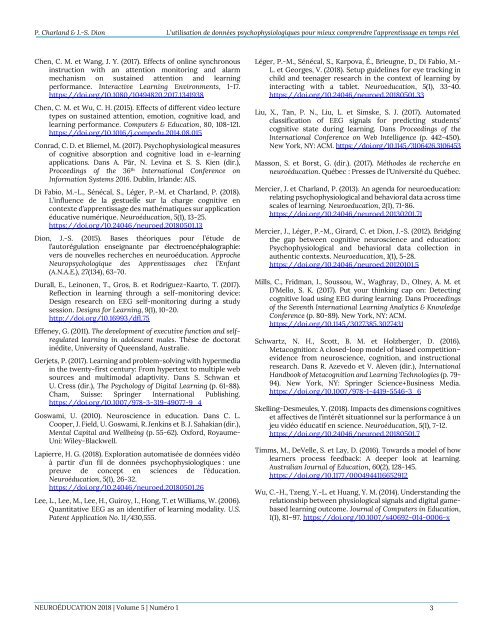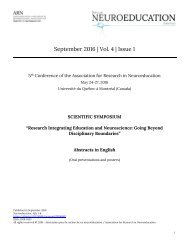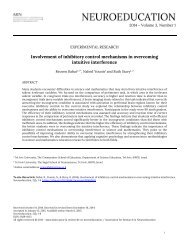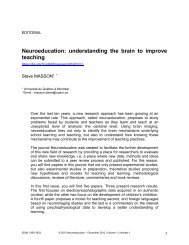Neuroeducation_2018_vol-5_no-1_full
Volume 5, Numéro 1 de la revue scientifique bilingue en libre accès Neuroéducation
Volume 5, Numéro 1 de la revue scientifique bilingue en libre accès Neuroéducation
- No tags were found...
Create successful ePaper yourself
Turn your PDF publications into a flip-book with our unique Google optimized e-Paper software.
P. Charland & J.-S. Dion L’utilisation de données psychophysiologiques pour mieux comprendre l’apprentissage en temps réel<br />
Chen, C. M. et Wang, J. Y. (2017). Effects of online synchro<strong>no</strong>us<br />
instruction with an attention monitoring and alarm<br />
mechanism on sustained attention and learning<br />
performance. Interactive Learning Environments, 1-17.<br />
https://doi.org/10.1080/10494820.2017.1341938<br />
Chen, C. M. et Wu, C. H. (2015). Effects of different video lecture<br />
types on sustained attention, emotion, cognitive load, and<br />
learning performance. Computers & Education, 80, 108-121.<br />
https://doi.org/10.1016/j.compedu.2014.08.015<br />
Conrad, C. D. et Bliemel, M. (2017). Psychophysiological measures<br />
of cognitive absorption and cognitive load in e-learning<br />
applications. Dans A. Pär, N. Levina et S. S. Kien (dir.),<br />
Proceedings of the 36 th International Conference on<br />
Information Systems 2016. Dublin, Irlande: AIS.<br />
Di Fabio, M.-L., Sénécal, S., Léger, P.-M. et Charland, P. (<strong>2018</strong>).<br />
L’influence de la gestuelle sur la charge cognitive en<br />
contexte d’apprentissage des mathématiques sur application<br />
éducative numérique. Neuroéducation, 5(1), 13-25.<br />
https://doi.org/10.24046/neuroed.<strong>2018</strong>0501.13<br />
Dion, J.-S. (2015). Bases théoriques pour l’étude de<br />
l’autorégulation enseignante par électroencéphalographie:<br />
vers de <strong>no</strong>uvelles recherches en neuroéducation. Approche<br />
Neuropsychologique des Apprentissages chez l’Enfant<br />
(A.N.A.E.), 27(134), 63-70.<br />
Durall, E., Lei<strong>no</strong>nen, T., Gros, B. et Rodriguez-Kaarto, T. (2017).<br />
Reflection in learning through a self-monitoring device:<br />
Design research on EEG self-monitoring during a study<br />
session. Designs for Learning, 9(1), 10-20.<br />
http://doi.org/10.16993/dfl.75<br />
Effeney, G. (2011). The development of executive function and selfregulated<br />
learning in adolescent males. Thèse de doctorat<br />
inédite, University of Queensland, Australie.<br />
Gerjets, P. (2017). Learning and problem-solving with hypermedia<br />
in the twenty-first century: From hypertext to multiple web<br />
sources and multimodal adaptivity. Dans S. Schwan et<br />
U. Cress (dir.), The Psychology of Digital Learning (p. 61-88).<br />
Cham, Suisse: Springer International Publishing.<br />
https://doi.org/10.1007/978-3-319-49077-9_4<br />
Goswami, U. (2010). Neuroscience in education. Dans C. L.<br />
Cooper, J. Field, U. Goswami, R. Jenkins et B. J. Sahakian (dir.),<br />
Mental Capital and Wellbeing (p. 55-62). Oxford, Royaume-<br />
Uni: Wiley-Blackwell.<br />
Lapierre, H. G. (<strong>2018</strong>). Exploration automatisée de données vidéo<br />
à partir d’un fil de données psychophysiologiques : une<br />
preuve de concept en sciences de l’éducation.<br />
Neuroéducation, 5(1), 26-32.<br />
https://doi.org/10.24046/neuroed.<strong>2018</strong>0501.26<br />
Lee, L., Lee, M., Lee, H., Guiroy, I., Hong, T. et Williams, W. (2006).<br />
Quantitative EEG as an identifier of learning modality. U.S.<br />
Patent Application No. 11/430,555.<br />
Léger, P.-M., Sénécal, S., Karpova, É., Brieugne, D., Di Fabio, M.-<br />
L. et Georges, V. (<strong>2018</strong>). Setup guidelines for eye tracking in<br />
child and teenager research in the context of learning by<br />
interacting with a tablet. <strong>Neuroeducation</strong>, 5(1), 33-40.<br />
https://doi.org/10.24046/neuroed.<strong>2018</strong>0501.33<br />
Liu, X., Tan, P. N., Liu, L. et Simske, S. J. (2017). Automated<br />
classification of EEG signals for predicting students’<br />
cognitive state during learning. Dans Proceedings of the<br />
International Conference on Web Intelligence (p. 442-450).<br />
New York, NY: ACM. https://doi.org/10.1145/3106426.3106453<br />
Masson, S. et Borst, G. (dir.). (2017). Méthodes de recherche en<br />
neuroéducation. Québec : Presses de l’Université du Québec.<br />
Mercier, J. et Charland, P. (2013). An agenda for neuroeducation:<br />
relating psychophysiological and behavioral data across time<br />
scales of learning. <strong>Neuroeducation</strong>, 2(1), 71-86.<br />
https://doi.org/10.24046/neuroed.20130201.71<br />
Mercier, J., Léger, P.-M., Girard, C. et Dion, J.-S. (2012). Bridging<br />
the gap between cognitive neuroscience and education:<br />
Psychophysiological and behavioral data collection in<br />
authentic contexts. <strong>Neuroeducation</strong>, 1(1), 5-28.<br />
https://doi.org/10.24046/neuroed.20120101.5<br />
Mills, C., Fridman, I., Soussou, W., Waghray, D., Olney, A. M. et<br />
D’Mello, S. K. (2017). Put your thinking cap on: Detecting<br />
cognitive load using EEG during learning. Dans Proceedings<br />
of the Seventh International Learning Analytics & K<strong>no</strong>wledge<br />
Conference (p. 80-89). New York, NY: ACM.<br />
https://doi.org/10.1145/3027385.3027431<br />
Schwartz, N. H., Scott, B. M. et Holzberger, D. (2016).<br />
Metacognition: A closed-loop model of biased competition–<br />
evidence from neuroscience, cognition, and instructional<br />
research. Dans R. Azevedo et V. Aleven (dir.), International<br />
Handbook of Metacognition and Learning Tech<strong>no</strong>logies (p. 79-<br />
94). New York, NY: Springer Science+Business Media.<br />
https://doi.org/10.1007/978-1-4419-5546-3_6<br />
Skelling-Desmeules, Y. (<strong>2018</strong>). Impacts des dimensions cognitives<br />
et affectives de l’intérêt situationnel sur la performance à un<br />
jeu vidéo éducatif en science. Neuroéducation, 5(1), 7-12.<br />
https://doi.org/10.24046/neuroed.<strong>2018</strong>0501.7<br />
Timms, M., DeVelle, S. et Lay, D. (2016). Towards a model of how<br />
learners process feedback: A deeper look at learning.<br />
Australian Journal of Education, 60(2), 128-145.<br />
https://doi.org/10.1177/0004944116652912<br />
Wu, C.-H., Tzeng, Y.-L. et Huang, Y. M. (2014). Understanding the<br />
relationship between physiological signals and digital gamebased<br />
learning outcome. Journal of Computers in Education,<br />
1(1), 81–97. https://doi.org/10.1007/s40692-014-0006-x<br />
NEUROÉDUCATION <strong>2018</strong> | Volume 5 | Numéro 1 3








